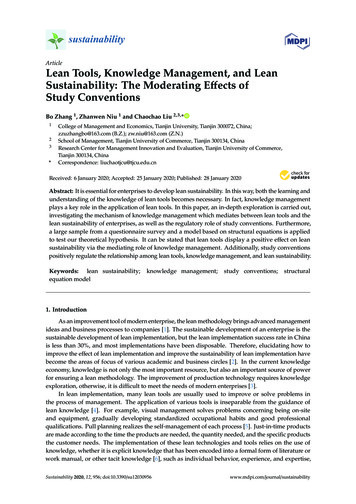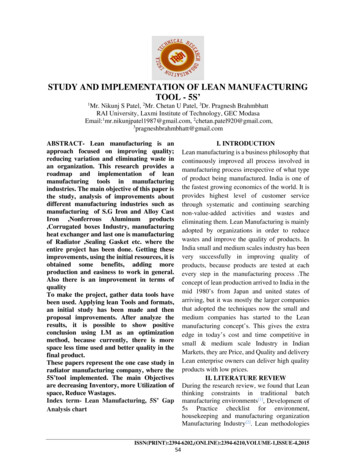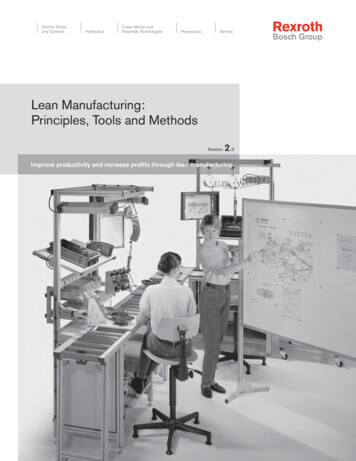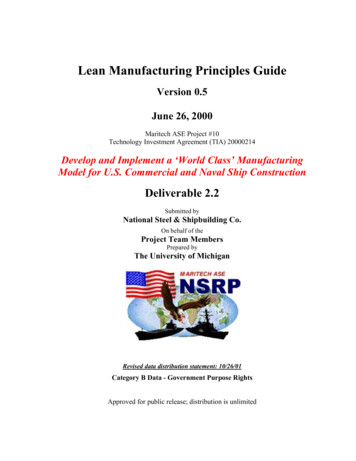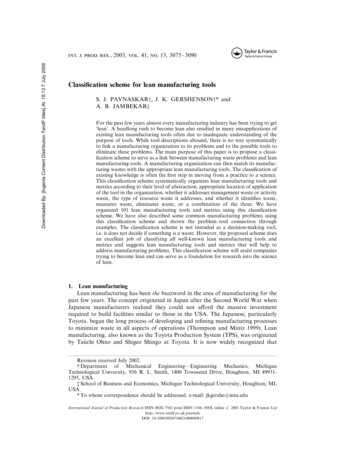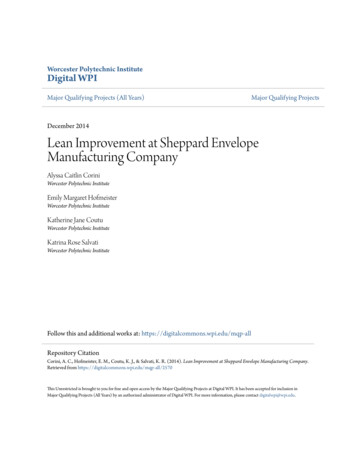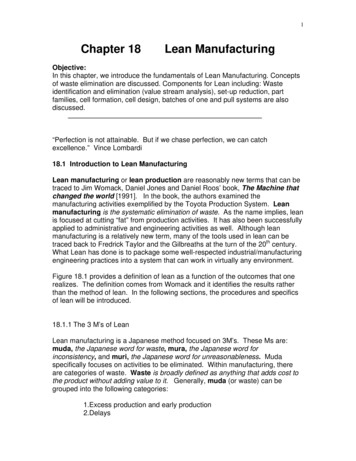
Transcription
1Chapter 18Lean ManufacturingObjective:In this chapter, we introduce the fundamentals of Lean Manufacturing. Conceptsof waste elimination are discussed. Components for Lean including: Wasteidentification and elimination (value stream analysis), set-up reduction, partfamilies, cell formation, cell design, batches of one and pull systems are alsodiscussed.“Perfection is not attainable. But if we chase perfection, we can catchexcellence.” Vince Lombardi18.1 Introduction to Lean ManufacturingLean manufacturing or lean production are reasonably new terms that can betraced to Jim Womack, Daniel Jones and Daniel Roos’ book, The Machine thatchanged the world [1991]. In the book, the authors examined themanufacturing activities exemplified by the Toyota Production System. Leanmanufacturing is the systematic elimination of waste. As the name implies, leanis focused at cutting “fat” from production activities. It has also been successfullyapplied to administrative and engineering activities as well. Although leanmanufacturing is a relatively new term, many of the tools used in lean can betraced back to Fredrick Taylor and the Gilbreaths at the turn of the 20th century.What Lean has done is to package some well-respected industrial/manufacturingengineering practices into a system that can work in virtually any environment.Figure 18.1 provides a definition of lean as a function of the outcomes that onerealizes. The definition comes from Womack and it identifies the results ratherthan the method of lean. In the following sections, the procedures and specificsof lean will be introduced.18.1.1 The 3 M’s of LeanLean manufacturing is a Japanese method focused on 3M’s. These Ms are:muda, the Japanese word for waste, mura, the Japanese word forinconsistency, and muri, the Japanese word for unreasonableness. Mudaspecifically focuses on activities to be eliminated. Within manufacturing, thereare categories of waste. Waste is broadly defined as anything that adds cost tothe product without adding value to it. Generally, muda (or waste) can begrouped into the following categories:1.Excess production and early production2.Delays
23.Movement and transportDefinition of “Lean” Half the hours of human effort in the factory Half the defects in the finished product One-third the hours of engineering effort Half the factory space for the same output A tenth or less of in-process inventoriesSource: The Machine that Changed the WorldWomack, Jones, Roos 1990Figure 18.1 An early definition of Lean.4.Poor process design5.Inventory6.Inefficient performance of a process7.Making defective itemsThese wastes are illustrated in Figure 18.2Excess production results in waste because it captures resources too early andretains the value that is added until the product can be used (sold). In today’shighly changing society, many items produced before they can are sold to aspecific customer often go obsolete before demand is realized. This means thata perfectly good product is often scrapped because it is obsolete. Producing aproduct simply to keep a production resource busy (either machine, operator orboth) is a practice that should be avoided.Delays, such as waiting for raw material, also result in the poor use of capacityand increased delivery time. Raw materials and component parts should becompleted at approximately the time that they will be required by downstreamresources. Too early is not good, but late is even worse.
3Movement and transportation should always be kept to a minimum. Materialhandling is a non-value added process that can result in three outcomes: 1) theproduct ends up at the right place at the right time and in good condition, 2) the7 Forms of WasteCORRECTIONWAITINGRepair orReworkAny non-work timewaiting for tools,supplies, parts, etc.PROCESSINGDoing more work thanis necessaryTypesofWasteINVENTORYMOTIONAny wasted motionto pick up parts orstack parts. Alsowasted walkingOVERPRODUCTIONProducing morethan is neededbefore it is neededCONVEYANCEMaintaining excessinventory of raw mat’ls, Wasted effort to transportmaterials, parts, orparts in process, orfinished goods into orfinished goods.out of storage, orbetweenprocesses.Figure 18.2 The seven Forms of waste.part ends up in the wrong place, and 3) the part is damaged in transit andrequires rework or scrap. Two of the three outcomes are no desirable, whichfurther leads to minimizing handling. Because material handling occurs betweenall operations, when possible, the handling should be integrated into the process,and the transport distances minimized.A poorly designed process results in overuse of manufacturing resources (menand machines). There are no perfect processes in manufacturing. Generally,process improvements are made regularly with new efficiencies embedded withinthe process. Continuous process improvement is a critical part of LeanManufacturing.Excess inventory reduces profitability. Today, it is not uncommon for amanufacturer to store a supplier’s product at the production site. The supplier,right up until the time that they are drawn from inventory, owns the materials. Inmany ways this is advantageous to both the user and supplier. The supplier
4warehouses his material offsite, and the user does need to commit capital to alarge “safety stock” of material.Insufficient (or poor) process performance always results in the over utilization ofmanufacturing resources and a more costly product. There is no optimal processin that improvements can always be made; however, many processes operate farbelow the desired efficiency. Continuous process improvement is necessary fora manufacturing firm to remain competitive. Excess movement or unnecessarypart handling should be the first targets of waste elimination.Poor quality (making defects) is never desirable. Labor and material wasteresults from producing any defect. Furthermore, the cost of mitigating poorquality (rework) can often exceed the price of the product. A critical balancebetween processing speed and quality exists. A process should be run as fastas possible without sacrificing acceptable quality.From the above discussion, it should be obvious that waste is a constant enemyof manufacturing. Waste elimination should be an on-going process that focuseson improving a process regularly. Regular reviews and worker input should beconducted as often as allowable.The second “M” is for mura, or inconsistency. Inconsistency is a problem thatincreases the variability of manufacturing. Mura is evidenced in allmanufacturing activities ranging from processing to material handling toengineering to management. Figures 18.3 and 18.4 illustrate somecharacterization of mura.Quality Processes Yield Quality tional People doing whatever they can to get resultsConsistentProcessDesiredResultsLean People using standard process to get resultsFigure 18.3 Inconsistency is a problem in manufacturing.
5Henry Ford - Standards“To standardize a method is to choose out of the manymethods the best one, and use it. Standardization meansnothing unless it means standardizing upward.Today’s standardization, instead of being a barricade againstimprovement, is the necessary foundation on whichtomorrow’s improvement will be based.If you think of “standardization” as the best that you knowtoday, but which is to be improved tomorrow - you getsomewhere. But if you think of standards as confining, thenprogress stops.”Henry Ford, 1926Today & TomorrowFigure 18.4 Henry Ford on standards (or against inconsistency).The final “M” is for muri or unreasonableness. Muri applies to a variety ofmanufacturing and management activities. For instance, Figure 18.5 shows anexample of being unreasonable by blaming someone for problems rather thanlooking at resolution of problems. It is unreasonable to blame rather thanmitigate issues. This is true for all manufacturing activities -- do what isreasonable. Don’t be emotional!New Paradigm: Non-Blaming CultureManagement creates a culture where: Problems are recognized as opportunities It’s okay to make legitimate mistakes Problems are exposed becauseof increased trust People are not problems they are problem solversPROBLEMSSOLUTIONS Emphasis is placed on finding solutions instead of“who did it”Figure 18.5 Be reasonable -- muri.
618.1.2 The 5 S’s of LeanMuch of Lean manufacturing is applying “common sense” tomanufacturing environments. In implementing Lean, 5 S’s are frequently used toassist in the organization of manufacturing. The 5 S’s are from Japanesse andare: Seiri (sort, necessary items) Seiton (set-in-order, efficient placement) Seison (sweep, cleanliness) Seiketsu (standardize, cont. improvement) Shitsuke (sustain, discipline)These concepts are illustrated in Figure 18.6.Figure 18.6. The 5 S’s of Lean.18.2 Laying out a Lean Production FacilityAnother critical aspect of Lean is the organization of the production facility.Since one of the keys to lean is waste elimination, the layout of any system
7should be arranged in such manners that waste of motion (material handling andmaterial transport) and elimination of inventory is part of the object for the layout.You may recall that there are two traditional forms of layout in manufacturing:process and product. In a process layout (or job shop as it is informallycalled), machines are organized and clustered by type, where typically all millsare in one department, all lathes in another, etc. In a product layout (or flowshop), machines are located so that sequential operations are performed atadjacent machines. These types of layout are illustrated in Figures 18.7 and18.8 respectively.MMDLMMLLMMLLMMAAAAFigure 18.7 A typical process or job shop layout.DDDDGGGGGG
8Part #1LLMDGAReceivingLMGAGPart #2LPart #3MDShippingFigure 18. 8 A typical product or flow shop layout.Process layout is typically employed for a large variety of products that aremade in very small batches (ones or twos). The advantages of Process Layoutare: 1) the flexibility of the system to product almost any part that fits within thevolumemetric boundaries of the machines, 2) an in depth understanding of aspecific process can be obtained, and 3) some tooling and fixtures can beshared. The disadvantages of process layout are: 1) the spaghetti flow isdifficult to manage and control, 2) there is usually a lot of inventory in front ofeach machine, 3) set up is usually expensive, 4) material handling times arelarge, and 5) it is difficult to automate these types of systems.Product layout systems are used effectively for the economic production ofhigh volume goods. The advantages of these systems are: 1) large batches canbe produced inexpensively, 2) material handling is minimal, 3) in-processmaterials are minimized, 4) it is easy to control these systems, and 5) automationis more achievable and justifiable. The disadvantages of these systems are: 1)they are inflexible, in that only one or very few products can be produced onthem, 2) set up time for these systems is very large, and 3) duplicate tooling isrequired to replace worn tooling so that maintenance can be minimized.Process systems work effectively on “one of a kind” type of production. Asbatches get larger, these systems fail to produce the required “economies ofscale”, and that production time and cost remains relatively constant. Productsystems work very effectively on single item production. For instance, highvolume products like soda, beer, canned foods, and cigarettes are effectivelyproduced on these flow systems. The reason that these items are soinexpensive is in part because of the way they are produced. Unfortunately, the
9high capital cost and long set-up for these systems mandates large volumes tooffset these initial cost and then the changeover costs for the system.In general, very low volume items should be produced on process typesystems, and very high volume items should be produced on product typesystems. A problem facing most manufacturers is that the general trend today isfor medium volume batches that change regularly. This means that process andproduct layout fails to meet the requirements for much of what is demandedtoday. The result is that a hybrid of the two systems has been developed. It iscalled a manufacturing cell. See Figure 18.9 and 18.10. Cells are used to makefamilies of parts, rather than just one-of-a-kinds or high volume items. Cells arelogical clusters of machines organized to produce a variety of parts requiring thesame equipment type, tooling and fixtures. Cells are intended to provide asmany of the benefits of process and product layouts as possible.Cell #2DDCell #1MIDCell #3LLDILMIMMFigure 18.9 A manufacturing cellular layout.InputOutputFigure 18.10 A “U – shaped” manufacturing cell.
10In many ways, cellular layout separates and groups products within amanufacturing system into smaller units. The strategy here is to identify partsthat belong to the same “product families”. A product family is a group ofproducts that normally look similar and require the same (or similar) processingsteps to produce. Traditionally, designers have formed product families bygrouping products that provide similar functions into a common product family.Examples might be: springs, clips, brackets, etc. The problem however becomesone where functional names may create very large families (for instance,brackets typically form a large portion of products the automotive industriesmake) or function may require different processes as the size scales. Grouptechnology (GT) was introduced as a method to characterize products intocode-able families. A descriptive code was used to characterize the productgeometry, function and/or method used to make the part. As database systemshave become more powerful, the code has been replaced with descriptive fieldsin a database. Today, more formal techniques are used to identify cells. In thefollowing section, a methodology to organize factories, machines
Lean manufacturing or lean production are reasonably new terms that can be traced to Jim Womack, Daniel Jones and Daniel Roos’ book, The Machine that changed the world [1991]. In the book, the authors examined the manufacturing activities exemplified by the Toyota Production System. Lean manufacturing is the systematic elimination of waste. As the name implies, lean is focused at cutting .


